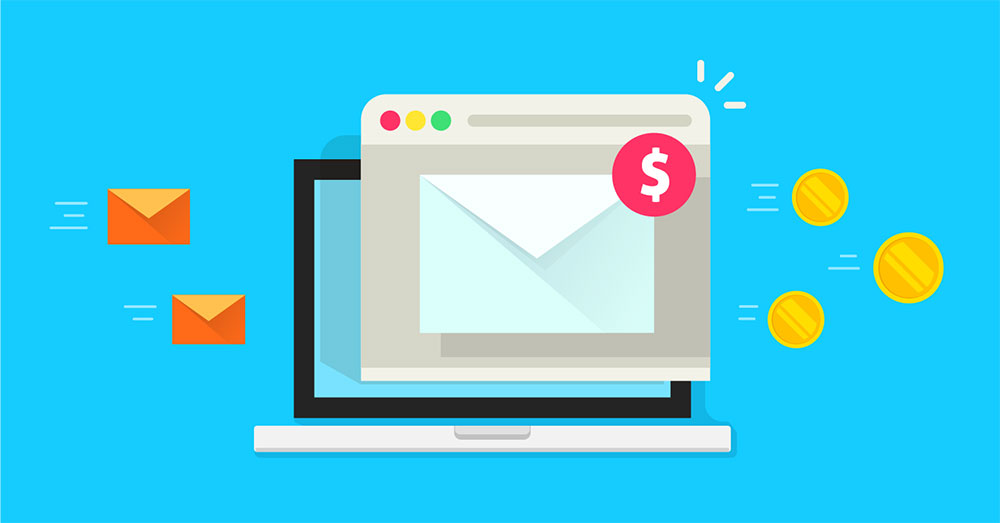Email marketing ROI is consistently high, most recently being reported at a rate of 38:1, on average, according to 372 marketers across the globe. If you’re not investing time or money into email campaigns, now is the time to revamp your plan. Consider the role this medium can play in your business, whether you’re starting with no list at all, or simply aren’t engaging with the subscribers you do have.
Here are five great reasons to put more focus on your email campaigns along with tips for being most effective with your time and money.
Drive Sales

If you already have a large email list, you can use it to drive repeat sales with current customers, suggests the blog post from FounderU, How to Promote a Product in 10 Different Ways. They explain, “Remember, you want to reach new customers and encourage repeat business without cutting too far into your profits.” An engaged email list is the best way to do that.
If you don’t have an email list yet, shift your focus to building one because most customers won’t make a purchase the first time they land on your site. When they subscribe, you can nurture them until they’re ready to buy.
To start building that email list, FounderU suggests offering a discount code as an opt-in. Not only does this give them a reason them to make their first purchase, but it gets them into a funnel where they’re given discounts and value-add content, encouraging them to purchase more. As you consider your discount, FounderU explains, “Remember that free shipping has a high perceived value, as do buy-one-get-one-free (BOGO) offers.” If you don’t have a tool to facilitate this yet, consider Woobox’s Coupons feature.
“Remember that free shipping has a high perceived value, as do buy-one-get-one-free (BOGO) offers.” -FounderU
Give Consumers What They Want

The 2018 Adobe Consumer Email Survey found that more than half of all consumers polled prefer to hear from brands via email, as opposed to direct mail, a mobile app or even social media. This is your chance to get in front of them on a platform where they expect and want to hear from you. If you’re struggling with budget for paid ads, for example, it may be wise to put more focus on email to be more effective.
That doesn’t mean you should start emailing your subscribers every single day, or even every week. The same Adobe survey found that 45% of customers say their biggest annoyance when receiving an email offer from a brand is getting emailed too often. In fact, read rates decrease dramatically, from .32 percent, at one email per week, down to .14 percent at eight emails per week.
“The same Adobe survey found that 45% of customers say their biggest annoyance when receiving an email offer from a brand is getting emailed too often.”
If you’re not sure how often to send emails to your subscribers, start slow. Track open rate and CTR as you increase your sends to make sure there’s not a significant dip in engagement. If you do see a drop, consider pulling back or checking that your emails are providing value.
Provide Extra Value

Whether your subscriber list is full of past purchasers or those who are new to your brand, you can use email to provide value.
Rather than asking them to make a purchase in every email, give them something. Adobe’s 2018 survey also found that consumers are looking for emails that add value. In fact, 39 percent said they want brands to “make them less about promotion and more about providing me information.”
Most commonly, these value-add emails are content-based, filled with blog posts, images and videos that are helpful and interesting. Another way to provide extra value is to host a giveaway; your subscribers simply complete a simple task to be entered to win. For example, Woobox’s Instant Win feature is a fun tool to use. With it, subscribers can instantly win a prize—whether that’s a steep discount or special giveaway item.
That immediate gratification can bode well for your brand—and may give them a reason to recommend you to friends and family. At a time when consumers trust brands less and less, this word of mouth marketing is critical.
Keep Subscribers Engaged
Subscribers are valuable to your business. They were at some point interested enough to subscribe to your list or make a purchase—and you want to keep them engaged. Not only so they can make their first or second purchase, but because it costs money to acquire subscribers, suggests Content Marketing Institute. This is especially true if you offered a monetary opt-in, like a discount.
“They were at some point interested enough to subscribe to your list or make a purchase—and you want to keep them engaged.”
If you don’t email them, you lose their interest. When you email regularly, and provide value, discounts and updates, you turn them into engaged subscribers. The same CMI guide suggests that these engaged subscribers are more valuable because they share your content more readily and take action.
By putting your focus on email campaigns, you can develop engaged subscribers who are ready to purchase from you and share about your brand.
Email is Easier to Track
It can be difficult to track the value of a blog post or social media post. While you can implement tracking to an extent, you end up having to dig through a variety of sources to get the full picture. Email marketing is easier to track thanks to built-in analytics and the ability to integrate various tools with your email provider of choice.
For example, you can integrate your Shopify account with your email account to see the revenue from each email send. This makes it much easier to attribute sales and ROI to your email marketing efforts. Don’t forget to tag any link that was also placed in the email so you can dive deeper into which elements were most impactful for driving sales.
Focus on Email Marketing
Don’t let email marketing fall to the wayside. Keep these benefits in mind as you develop a strategy and determine where to allocate marketing dollars. If you’re trying to reach the increasingly ad-fatigued consumer, email marketing can be an important medium for reaching potential customers where they want to be reached—allowing you to ge more from the time and money being spent.
